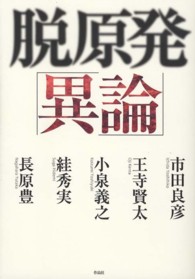- ホーム
- > 洋書
- > 英文書
- > Psychology
Full Description
It is estimated that, in the United States, around 20 percent of all Police-reported road crashes involve driver distraction as a contributing factor. This figure increases if other forms of inattention are considered. Evidence (reviewed in this volume) suggests that the situation is similar in other countries and that driver distraction and inattention are even more dangerous as contributing factors in crashes than drug and alcohol intoxication. Having a solid evidence-base from which to develop injury countermeasures is a cornerstone of road-safety management. This book adds to the accumulating evidence-base on driver distraction and inattention. With 24 chapters by 52 authors from more than 10 countries, it provides important new perspectives on the definition and meaning of driver distraction and inattention, the mechanisms that characterize them, the measurement of their effects, strategies for mitigating their effects, and recommendations for further research. The goal of this book is to inspire further research and countermeasure development to prevent and mitigate the potentially adverse effects of driver distraction and driver inattention, and, in doing so, to save lives.
Contents
Contentsand John D. Lee. Part II Distraction and Inattention - Theory, Philosophy and Definition: Driven to distraction and back again, Peter A. Hancock; Attention selection and multitasking in everyday driving: a conceptual model, Johan EngstrA m, Trent Victor and Gustav Markkula; Driver distraction and inattention: a queuing theory approach, John W. Senders; The relationship between driver distraction and mental workload, Nina Schaap, Richard van der Horst, Bart van Arem and Karel Brookhuis. Part III Visual and Attentional Processes: How is driving-related attention in driving with visual secondary tasks controlled? Evidence from top-down attentional control, Barbara Metz, Nadja Schoemig and Hans-Peter Krueger; Proposing a risk monitor model based on emotions and feelings: exploring the boundaries of perception and learning, Truls Vaa. Part IV Distraction - Crashes and Crash Risk: Driver distraction and inattention: top crash causes in the United States of America, Ralph H. Craft and Brian Preslopsky; Driver distraction in commercial motor vehicle operations, Richard J. Hanowski, Rebecca L. Olson, Jeffery S. Hickman and Joseph Bocanegra; Driver distraction and inattention and their role in crashes and safety-critical events, Craig P. Gordon and Michael A. Regan; A review of epidemiological data on the risks of using a telephone while driving, Jean-Louis Martin; Drivers' perceptions of risk linked to mobile phone use while driving and implications for the design of driver awareness campaigns, Corinne Brusque. Part V Distraction - Measurement: Development and validation of an ecological driver distraction evaluation tool, Kristie L. Young, Michael G. Lenne, Jeffery Archer and Amy Williamson; Oculometric measures as an index of clinical causes of driver drowsiness and inattention, William Torch and Carlos Cardillo. Part VI Distraction - Effects on Driving Performance: Driving whilst using in-vehicle i







